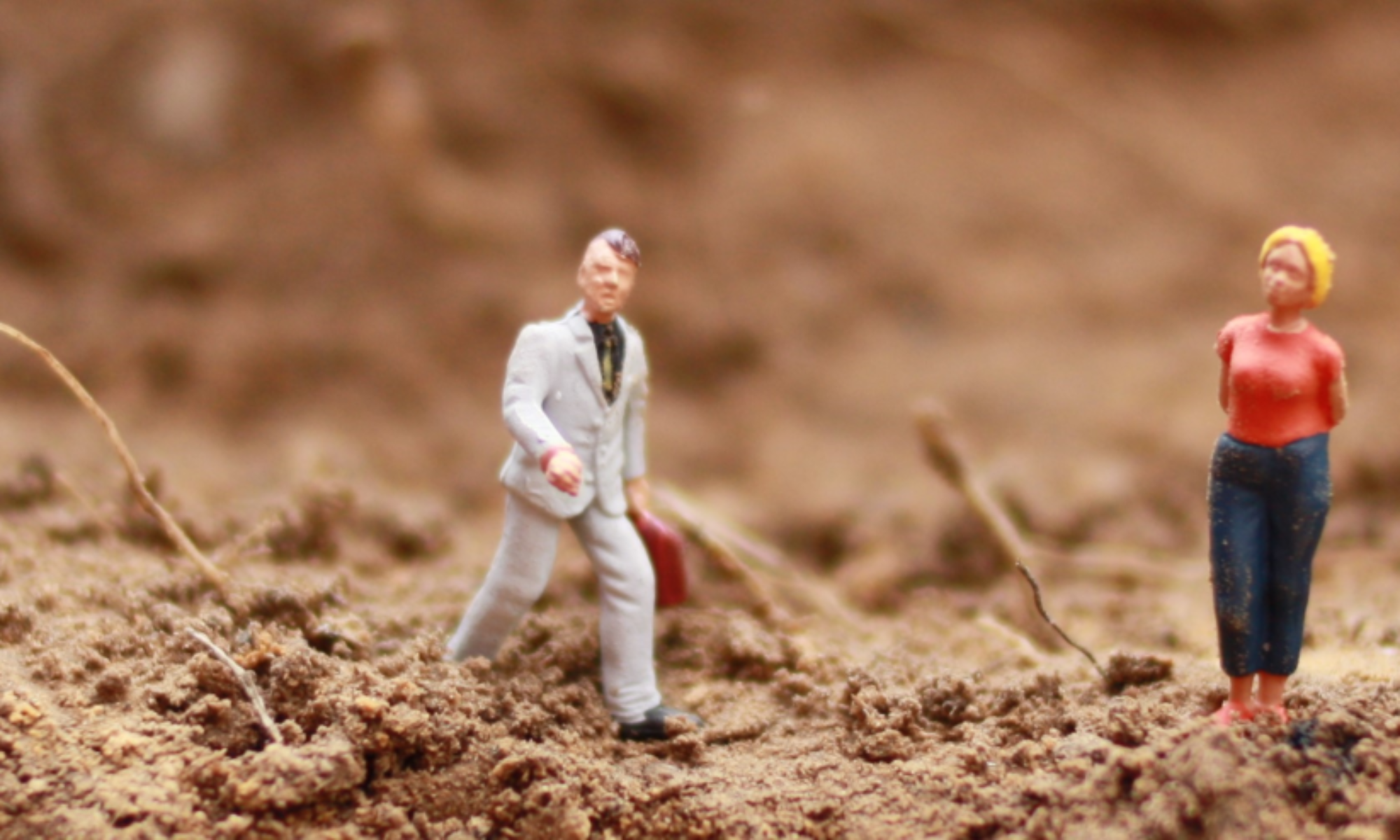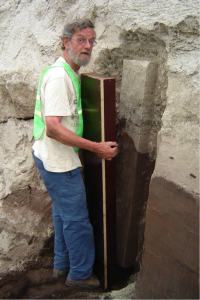In Memoriam: Marcel Jamagne 1931-2015
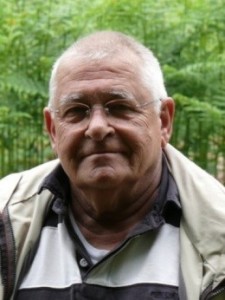
Marcel Jamagne est décédé à Orléans le 30 septembre 2015. Il était né à Bruxelles le 17 novembre 1931.
De nationalité belge, il prend la nationalité française en 1978. Après des études d’ingénieur agronome, spécialisation eaux et forêts à La Faculté des Sciences agronomiques de Gembloux, et son service militaire en qualité d’officier de réserve à l’armée de l’air, il commence en 1957 une carrière de pédologue cartographe à la Division d’agrologie de l’INEAC, l’Institut national pour l’étude agronomique du Congo (aujourd’hui République démocratique du Congo).
Ce groupe Prospection et Cartographie de la Division d’agrologie est dirigé par Carl Sys qui deviendra par la suite professeur de pédologie tropicale à l’Université de Gand. Durant cette période congolaise, Marcel Jamagne effectue deux missions pédologiques importantes, celle de la Tshuapa dans la cuvette du fleuve Congo et celle du Maniema en limite du Sud Kivu. Il participe également à la rédaction de l’ouvrage « La cartographie des sols au Congo, ses principes et ses méthodes » (Sys, 1961) qui est le premier manuel publié en français sur les méthodes de cartographie des sols.
De retour en Belgique en août 1960 suite aux événements dramatiques se déroulant au Congo devenu indépendant, il intègre le Service de la Carte des sols de Belgique (Directeur : René Tavernier) et participe à la prospection pédologique en Ardennes en collaboration avec Joseph Deckers (le père de Seppe).
A la même période, en France, Jean Hébert (INRA) directeur de la Station agronomique de Laon crée le Service de la Carte des sols du département de l’Aisne. Ce jeune service a pour mission d’établir une carte des sols à moyenne échelle (1/25 000) à partir de levés de terrain à grande échelle (1/5000) sur tout le département. Pour développer ce service, Jean Hébert connaissant le travail identique réalisé pour la carte des sols de Belgique s’adresse à René Tavernier pour obtenir sa collaboration par l’intermédiaire de l’un de ses pédologues expérimentés. Marcel Jamagne devient ainsi en 1961 le Directeur du Service de la Carte des Sols de l’Aisne, direction qu’il quitte en 1969.
Durant ces années “Jamagne”, le Service connaît un développement exceptionnel grâce à ses compétences, son efficacité et son rayonnement. Le rayonnement du Service de l’Aisne est non seulement national mais aussi européen. Marcel Jamagne soutient et encourage aussi ses adjoints à l’étude des sols (recherches en pédogenèse) ainsi qu’à la formation continue. Lui-même suit la licence de cartographie des sols (1966) dispensée par l’Université de Gand où il présente un mémoire sur l’aspect micromorphologique des sols sur limon lœssique.
A partir de ses expériences de la cartographie des sols en Belgique, au Congo puis maintenant en France, il publie un ouvrage qui fera date en pédologie de terrain et deviendra un référentiel pour de nombreux pédologues ; il s’agit de « Bases et techniques d’une cartographie des sols » (INRA, 1967). Parallèlement, il entreprend une recherche fondamentale sur l’évolution des sols lessivés du Bassin de Paris, recherche qui aboutit en 1973 à la soutenance d’une thèse de doctorat à la Faculté Universitaire des Sciences agronomiques de Gembloux sous le titre « Contribution à l’étude pédogénétique des formations lœssiques du Nord de la France ».
Pendant cette période s’élabore sous la direction de Jean Boulaine et de René Bétremieux la classification française des sols qui voit le jour en 1967 et à laquelle participe activement Marcel Jamagne. Toujours durant cette période (1967-1968), Gustave Drouineau, alors inspecteur général de l’INRA plaide la création du Service d’Etude des Sols et de la Carte Pédologique de France (SESCPF) et c’est à Marcel Jamagne qu’est confiée en 1969 la direction et le développement de ce nouveau Service. Ce Service s’installe d’abord dans le centre INRA à Versailles et les travaux sont presque exclusivement orientés vers la cartographie des sols pour une présentation à 1/100 000 selon le découpage de l’IGN et par rapport à un schéma de classement taxonomique. En 1982, le Service s’installe dans des nouveaux bâtiments à Orléans. Petit à petit ; la cartographie des Sols évolue vers la représentation de séquences paysagiques basées sur la notion de « pédopaysage ».
La dynamique du SESCPF insufflée par Marcel Jamagne va conduire à la réalisation de nombreuses actions de recherches se rapportant à la compréhension de la distribution, du comportement et du fonctionnement des sols dans le milieu naturel. Avec l’installation à Orléans, le Service s’enrichit d’un laboratoire de physique et de minéralogie des sols et d’une unité d’informatique.
En 1990, le programme IGCS (Inventaire, Gestion et Conservation des sols) élaborant pour les grandes régions administratives une base de données à 1/250 000 et pour des secteurs de référence des documents à 1/10 000 prend la suite du programme initial des cartes à 1/100 000.
Conjointement au développement et à la direction de tous ces programmes traitant de l’espace national, Marcel Jamagne participe à différents programmes européens et internationaux (FAO, UNESCO, CCE puis UE) tout particulièrement par le canal du Centre Commun de Recherches (JRC : Joint Research Center) puis du Bureau Européen des Sols à Ispra. Grâce à la compétence reconnue des ingénieurs du Service, celui-ci se voit confier progressivement la coordination scientifique de plusieurs programmes importants dont celui de la Base de Données Géographiques des Sols de l’Europe (Soil Geographical Data Base for Eurasia and the Méditerranean) sans compter la participation à d’autres programmes en Amérique latine et en Asie. Marcel Jamagne peut être considéré comme le père de la cartographie des sols en France et un des pères de celle en Europe.
Il quitte officiellement la direction du SESCPF en 1997 quand celui-ci est scindé en deux unités : Infosol et Science du Sol. Il est alors nommé par l’INRA Directeur de recherche émérite et chargé de mission. Mais a-t-il un jour vraiment pris sa retraite ? Chargé de mission, il s’implique surtout dans le programme de la Base de Données Géographiques des Sols de l’Europe. Il continue à intervenir (1994-2004) dans le DEA national de pédologie et particulièrement lors des camps de terrain. Il rédige également un remarquable ouvrage de synthèse sur les sols de France avec pour titre « Grands paysages pédologiques de France ». (Quae, 2011). Quelques semaines avant son décès, il travaillait encore à l’actualisation d’une carte des sols à 1/100 000.
Marcel Jamagne était membre de l’Académie d’Agriculture de France et membre d’honneur de l’Union Internationale de Science du Sol, chevalier de la Légion d’honneur et officier du Mérite agricole (France). Il a été président de l’Association française pour l’Etude du sol (1996-1999) et vice-président de l’IUSS (1994-1998)
En dehors du scientifique exceptionnel et du chef remarquable, Marcel Jamagne était un homme extrêmement chaleureux, très humain, au regard pétillant, au sourire malin, ayant toujours un mot pour redonner de l’entrain. S’il avait une ambition personnelle, celle de rendre toujours son travail le plus achevé possible, il était également soucieux de la promotion de ses collaborateurs, du plus petit technicien jusqu’à l’ingénieur.
Marcel Jamagne était un travailleur exceptionnel et infatigable. Combien de week-ends passés à reprendre des textes de publication ou de rapports, combien de soirées de travail dans son bureau personnel ou sur la table du salon jusqu’à ce que la fatigue l’abatte et l’oblige à prendre un court repos. Toute cette somme de travail, tous ces écrits n’ont pu être réalisés que grâce à l’amour de Christiane, son épouse, qui a accepté un sacrifice peu commun que d’autres auraient refusé, quand ce n’étaient pas d’autres soirées entre amis pédologues où nous refaisions le monde de la pédologie.
Aucun de ceux qui l’ont connu, Aucun de ceux qui l’ont approché de près ou de loin, personne ne l’oubliera. Marcel Jamagne lègue à la Science du sol un héritage d’une richesse et d’une importance remarquables qui marquera pour longtemps notre discipline.
Clément MATHIEU
Obituary for Otto Spaargaren by Seppe Deckers
Otto Spaargaren passed away at Bennekom on March 13th 2015 at the age of 71.
Everybody will remember Otto as the winner of the third IUSS Guy Smith Award with which the IUSS community recognized him for his major contributions to international soil classification and correlation with special reference to the World Reference Base for Soil Resources (WRB).
Otto started his professional career as Educational Officer at the International Soil Museum (now ISRIC – World Soil Information), Wageningen from where he undertook numerous soils projects all over the world: soil survey for rice production in the Niger Delta in Nigeria; soil survey for the Mahaweli Development Project in Eastern Sri Lanka; feasibility for irrigation in Western Nepal. Otto also spent numerous years overseas in various projects such as the Soil Survey of Zambia and Coordinating the African Acid Soils Network of the International Board for Soil Research and Management (IBSRAM). Otto spearheaded under FAO the first classification system for top soils in the world and was involved in the work on Land Quality Indicators (LQI) under the authority from the World Bank.
From 2006 to 2010 he was the Chair of the IUSS Working Group WRB and from its foundation till 2006 he served as Vice-Chair and Secretary of the Working Group.
Otto was a soil classifier in heart and soul. His contribution to international soil classification may be defined as designing and checking its architecture (and controlling its rules). The other dimension in Otto’s approach was harmony both within one system and among systems. In Otto’s world of soil classification, WRB has its unique place which he iconized as “umbrella between equally worthy national soil classification systems”. With his concern to come to harmonization with Soil Taxonomy, Otto made numerous moves with the definitions of the diagnostics in WRB, so as to bring WRB and Soil Taxonomy closer to each other.
Otto’s enthusiasm for soilscapes has inspired many young soil scientists. He really was a master in animating the discussions in the profile pits and then bringing the floating ideas towards a consensus by projecting them on his vast field experience. Not only that, during numerous field excursions in the margin of international soil congresses, Otto would sneak out to collect numerous soil monoliths which are now on display in the soil museum at ISRIC and at the places of origin. In the quietness of the magnificently refurbished International Soil Museum at ISRIC, Wageningen, The Netherlands, Otto Spaargaren will always remain present through the numerous soil monoliths which will continue inspiring people from around the world in eternity.
Jozef (Seppe) Deckers, KU Leuven
Belgium
Young Soil Scientist day 2015
Day of the Young Soil Scientist: Invitation and call for abstracts
Date: Wednesday April 1, 2015
» Keynote by Prof. Oliver Chadwick
2015 is the International Year of Soils. Have a look on our blog ‘Jaar van de Bodem‘!
Programme Thematic Day ’14
Soil-plant interactions in a changing world
DATE: Friday December 5th, 2014 (9:00 – 12:30)
VENUE: The Royal Academies for Science and the Arts of Belgium (Rubenszaal), Hertogsstraat 1 Rue Ducale, Brussels
REGISTRATION: see below or follow this link
» Download the book of abstracts here!
Soil, plants and chemistry
09:00-09:20 ‘Capacity of microorganisms to decompose organic carbon affected by an increasing content of reactive mineral phases in a podzolic soil chronosequence.’ Vermeire et al. (UCL)
09:20-09:40 ‘Calibration of δD n-alkane as paleo-climate proxy in the DeepCHALLA archive.’ De Wispelaere et al. (UGent)
09:40-10:00 ‘Effects of different types of fertilizers on phosphorus availability in a soil with low P content.’ Barbieux et al. (ULg)
Coffee break (30 min) + poster session
Soils and plant roots
10:30-10:45 ‘Can root distribution be related to soil water potential in an irrigated ‘Conference’ pear orchard?’ Janssens et al. (Soil Service of Belgium)
10:45-11:00 ‘A review of the effects of plant roots on concentrated flow erosion.’ Vannoppen et al. (KULeuven)
11:00-11:15 ‘Can electrical resistivity tomography offer us a dynamic view on what happens in the soil-plant continuum?’ Garré et al. (ULg)
11:15-11:30 ‘Differential hydrological strategies: a stable isotope perspective on trees water sources.’ Hervé-Fernández et al. (UGent)
11:30-11:45 ‘Improving macroscopic modelling of water and osmotic stresses on root water uptake.’ Jorda Guerra et al. (KULeuven)
11:45-12:15 Invited talk: ‘Water relations in the soil-plant system: what can we learn from functional-structural plant models.’ Lobet et al. (ULg)
SSSB Thematic day 2014: Plant-soil interactions in a changing world
The uptake of water and nutrients by plants from the soil are key processes controlling mass and energy fluxes within the soil-plant-atmosphere continuum. Small-scale interactions at the soil-plant interface may have global scale and long-term effects on water, carbon, nitrogen and energy balances. Understanding these interactions, their effect on rooting behavior and on soil characteristics, and clarifying their manifestation at ecosystem scale is critical for predicting impacts of global change and climate variability on carbon, nutrient and hydrologic cycles. For the SSSB thematic day, we solicit investigations unraveling parts of this fascinating interplay between plants and soils.
The SSSB thematic day is organized on the World Soil Day, a day to celebrate the importance of soil as a critical component of the natural system and as a v
ital contributor to human wellbeing.
Date: December 5th, 2014
Location: The Royal Academies for Science and the Arts of Belgium (Rubenszaal), Hertogsstraat 1 Rue Ducale, B-1000 BRUSSELS
Registration: https://docs.google.com/forms/d/1K9fgOnEOfn-26h9207r-tFjK311sgtccUaeA0_627gs/viewform?usp=send_form
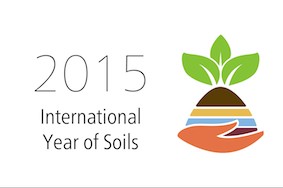
Two-day excursion to the International Soil Reference and Information Centre and to the periglacial soilscapes around Wageningen | June 2-3, 2014
Dear all,
Hereby I am happy to announce the 2014 excursion of the Soil Science Society of Belgium:
Two-day excursion to the International Soil Reference and Information Centre and to the periglacial soilscapes around Wageningen
June 2-3, 2014
Kindly find the invitation and registration form attached to this email. Please register before MAY 5 if you want to join.
Best regards,
Karen Vancampenhout
Last honours to Raoul Dudal
Raoul (Rudi) Dudal (Brugge, May 1, 1926 – Borchtlombeek, January 23, 2014)
On 23rd January 2014 Rudi Dudal passed away at Borchtlombeek, surrounded by his family. Rudi Dudal was born on May 1, 1926 in Brugge, Belgium.
Professional assignments
After his M.Sc. as agricultural engineer at KU Leuven University(Belgium) in 1949, Rudi stepped in a PhD programme at the Faculty of Agricultural Sciences where he was the first student to graduate in 1955. He was active as head of a mapping team of the Belgian Soil Survey Centre in Leuven. In 1955 he started his international career in FAO as Technical Assistant on Soil Resources Appraisal in Indonesia, where he also served as Professor in Soil Science in the faculty of Agricultural Sciences at the University of Indonesia from 1958 – 1959. From 1960 – 1969 he was the General Correlator of the FAO/Unesco Soil Map of the World. These were times of cold war and as our Russian colleagues from the Dokuchaev Soil Science Society remarked, this was Glasnost ‘avant la-lettre!’. From 1970 – 1975 Rudi was Chief of the Soil Resources Development and Conservation Service of FAO. From 1976 till 1984 he was Director of the Land and Water Development Division in FAO. In 1984 he joined KU Leuven as full professor in Soil Geography, Soils of the Tropics and Land Evaluation at the Faculty of Agricultural and Applied Biological Sciences.
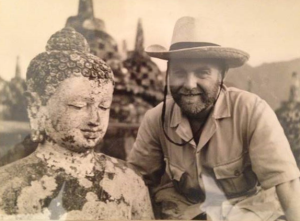
Internationally Rudi Dudal has taken on board numerous scientific assignments, the most important are :
- Chairman of the Commission on Soil Classification and Survey of the International Soil Science Society (ISSS; 1968 – 1974);
- Secretary-General of the International Soil Science Society (ISSS; 1974 – 1978); Chairman, FAO Inter-Departmental Working Group on Environment and Energy (1980 – 1983);
- Secretary of the Working Group on the International Reference Base for Soil Classification (ISSS; 1986 – 1992);
- Secretary of the Working Group on Soils and Geomedicine (ISSS; 1986 – 1994).
Rudi has also been very active in transdisciplinary scientific committees such as the Consultative Group on International Agricultural Research (CGIAR) where he served as a member of the Technical Advisory Committee (TAC) from 1988 – 1993 and as a member of the Board of Trustees of the International Center for Agricultural Research in Dry Areas (ICARDA) from 1995 – 2001. He launched the concept of Mega-Environments, kind of an agro-ecological zoning, to encourage scientists to target their research so small local farmers would reap more benefits.
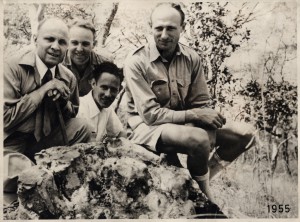
(first left) , J. Croegaert (third from the left) and C. Sys (fourth from the left), photo: courtesy E. Van Ranst
Rudy Dudal (second from the left) in Katanga, Congo on a soil corerelation tour with R. Tavernier
(first left) , J. Croegaert (third from the left) and C. Sys (fourth from the left), photo: courtesy E. Van Ranst
Rudi was awarded numerous honorary degrees:
- the degree of Doctor h.c. of Agricultural Sciences at the Rijksuniversiteit Gent,Belgium in 1976;
- Doctor of Science h.c. at the Cranfield University, U.K. in 1979
- Doctor of Laws h.c. at the University of Aberdeen, U.K in 1981.
Rudi’s high scientific profile was marked by Honorary Awards and memberships:
- Member of the Royal Academy of Overseas Science, (Belgium, 1979)
- Corresponding Member of the Deutsche Bodenkundliche Gesellschaft (Germany, 1980)
- Honorary Award of the Soil Conservation Society of America(U.S.A., 1981)
- Membre d’honneur, Association francaise pour l’Etude du Sol, (France, 1982)
- Honorary Member, American Soil Science Society, (U.S.A., 1985)
- Member of the Norwegian Academy of Sciences and Letters, (Norway, 1989)
Last but not least, Rudi was the first soil scientist to receive the Guy Smith Medal Award 2010 , which was handed over to him by Prof. Karl Star, Chair of IUSS Division of Soil ins Space and Time at the Royal Academy for Science and Arts at Brussels on 22/02/2011.
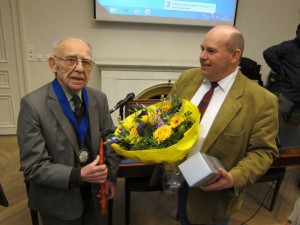
Rudy was member of the soil science societies of Belgium, Germany, USA, France, Norway, Romania, Bulgaria, Italy, ISRIC and the IUSS.
Rudi’s contributions to soil classification: By developing the Legend of the FAO/Unesco Soil Map of the World, Rudi made a major contribution towards harmonizing existing national soil classification systems. Thanks to his good personal relations at the time with Guy Smith from USDA, Rudi took the fortunate decision to adopt the concept of diagnostic horizons, properties and materials and implemented it at World scale in the FAO Legend of the Soil Map of the World. This was so successful that afterwards many countries used the Legend of the Soil Map of the World not only for soil mapping but also as a system for soil classification.
When in 1980 FAO and UNEP took the initiative of the International Reference base for Soil Classification (IRB), Rudi was there to steer the initiative and became secretary as of 1986 through to 1992. During the famous meeting of IRB at Montpellier in 1992, Rudi has played a key role in aligning the IRB with the revised legend of the FAO Soil map of the World. As such the World Reference Base for Soil Resources (WRB) was born and could count on the full support from FAO and other organizations of the United Nations. In 1998, during the World Congress of Soil Science at Montpellier, the IUSS adopted WRB as its system for soil correlation and classification. Rudi continued to play an important role by supporting harmonization in soil classification, particularly in the translation of the soil map of Belgium to WRB. With his phenomenal background rooting back to his time as a Belgian soil surveyor and all what followed during his career as prominent soil scientist, we have been very happy and proud to have had Rudi on this team.
Till very recent, Rudi was still keeping in close touch with the scholars in soil science at the Geo-Institute of the KU Leuven, stirring up the scientific debate on major world issues such as carbon cycles and soil evolution under the global change scenario. He loved socializing and discussing the most different themes. While tearing off the label of a water bottle, he would read out its mineral composition and then the latest nitrate regulations for Flanders groundwater would pass the review. Another of your favorite topics was climate change, long before Al Gore’s Inconvenient Truth was shown in the cinemas. And to our big surprise he not only told us the history of the carillon of Leuven town but even the music played on it every hour!
Through his kindness and enthusiasm he managed to endear so many people all over the world with whom he remained connected long before internet and social media were in place. This vast social capital in combination with his wisdom and vision made him a real leader.
When the sad news of Rudi Dudal’s passing away circulated a tsunami of emotional reactions came flooding in. “Rudi was a giant; we shall remember him fondly as a friend, colleague and polymath, stalwart to the end (David Dent), the scientist with the greatest sense of humour (Freddy Nachtergaele). We shall miss his counsel greatly (David Dent).
Indeed, we are very sad with Rudi’s departure, but we are also very grateful that our paths have crossed Rudi’s and we could travel together his life journey for so long. Dick Arnold from the United States put it like this: ‘Rudi will be missed but more importantly he will be remembered for his ideas and his determination to get soil scientists around the world to work more closely together’.
Geo-Institute
Department of Earth and Environmental Sciences
Celestijnenlaan 200 E
3001 Heverlee
Seppe.deckers@ees.kuleuven.be
Young Soil Scientists days 2014
Every year the Soil Science Society of Belgium is organizing a Day for the Young Soil Scientists.
The idea is that young soil scientists from Belgium get to know each other, learn about new research initiatives undertaken by the different research groups, both in Belgium and abroad.
Last year we have developed a new concept for the Young Scientists Day so as to accommodate many more participants and hence make the meeting more attractive for all.
Date: 26/02/2014 from 13:30 – 17:30
All research groups are invited to send abstracts for ONE oral presentation and as many as possible posters.
The scientific programme
- A limited number of oral presentations: one presentation per research group
(15 min. presentation + 5 min. discussion each) - A session of synthetic poster presentations; there is no limit to the number of poster presentations!
(3 min. each = 2 slides each)
Also this year’s M.Sc. thesis students are warmly encouraged to make a poster on their actual thesis work, with special attention to the research question they are trying to answer and the methods of their research. The results may be subject of a paper during the Young Scientists day Anno 2015! - Poster session with drinks served.
Subscriptions and abstracts
Subscription for this event is possible until Friday January 31, 2014 by filling out the online registration form.
The submission of abstracts will expire at February 9th, 2014.
Please send your title and abstract in English in time to Giles Colinet (Gilles.Colinet@ulg.ac.be). Don’t forget to mention the co-authors and their affiliations.
Looking forward to an overwhelming response, especially from our new generation soil scientists, we send you our best wishes.
Yours sincerely,
Martine Swerts, President SSSB
Gilles Colinet, Secretary-Treasurer SSSB
IN MEMORIAM: Mrs. Sofie Bruneel

On July 25th 2013, our colleague Sofie Bruneel sadly passed away due to the consequences of an illness. For over a decade, Sofie was the right hand of the Secretary-General. She voluntaily arranged so many things for our society, all with an unmatched dedication and efficiency.
To name a few: Sofie organized all practical issues of thematic days and excursions, managed budgets and records, followed-up with the IUSS and the Royal Academy, handled memberships and actively maintained communication with our members. Her commitment did not go unnoticed: with her help, memberships were steadily increasing.
We are extremely grateful to Sofie for all the work she put in. But even more than that, we will miss her kind personality and positive approach. She always had a smile and friendly word for everyone, was interested in our personal endeavors and no matter what it was one asked her advice for, she would do whatever she could to help out.
When we discussed the future of the society only weeks before she died, she was so enthousiastic about the success of the excursion and the increasing number of young soil scientists that had joined.
Karen Vancampenhout, Secretary-General Soil Science Society of Belgium
